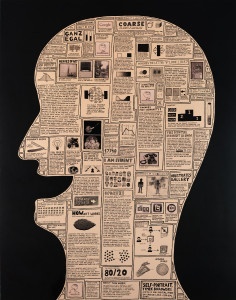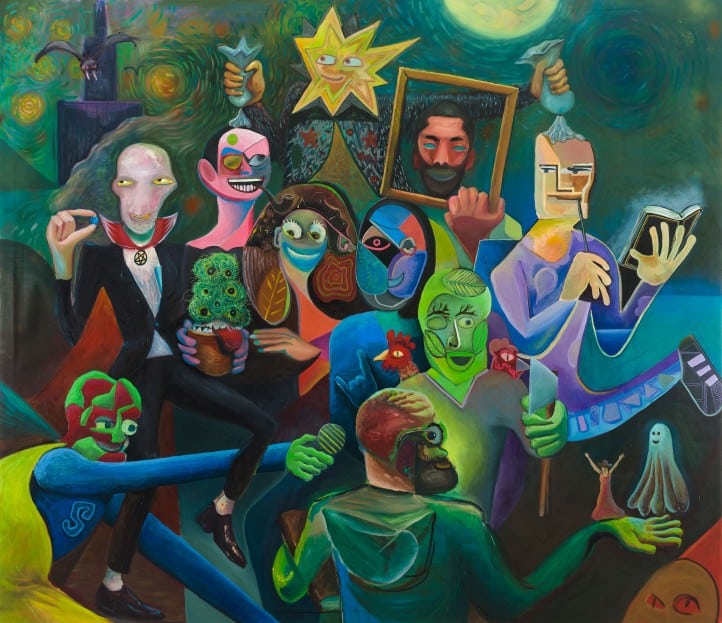Contemporary Lynx: You made your debut with a solo exhibition in 2008, as a fourth year student at the Academy of Fine Arts in Warsaw in the studio of Leon Tarasewicz. At the time you painted surrealistic works. You were focused on composition and on artistic aspects of paintings. Today you are an artist, who creates on the Internet and takes advantage of new media. How did transformation happen – from a traditional painter into a new media artist?
Tymek Borowski: Painting was good for me and I made quite a good money doing it. I was a little bored with it, crazy with being focused on one “style” but at the same time I was also afraid to leave this “comfort zone”. However, at one point I was brave enough to do it. I engaged myself in topics which interested me for a long time (but wasn’t visible in my art) by using solutions which were just around the corner – these were digital stuff and the Internet. To make it short, I allowed myself to do exactly what I want.
I have to point out that I do not consider myself as “an artist of new media.” I think about this as an additional element of my whole art without getting rid of those more traditional ones. It is not the point to replace one dogmatism with another. It is not the point to define yourself by something you don’t use.

Tymek Borowski, Self-portrait (fragment), acrylic and computer prints on canvas, 150 x 190 cm, 2011, courtesy of artist
CL: Often in your works you immediately inform that topics which you discuss are treated very seriously and your video-animations and presentations are not ironic. The surrealistic sentence “This is not a pipe” comes to mind. Is it about emphasizing the importance of your works or is it about something else?
TB: It is just about emphasizing that this is not a joke. With art it is often difficult to tell something seriously and direct statements appear to be suspicious. Of course this declaration about lack of irony occurred to be not really successful.
One of the problems of contemporary art is this habit to analyse a metaphorical aspects of the fact than an artist has done something rather than taking a closer look at his or her work. It is like asking a cook about what did he mean by adding a sausage into a pan.
CL: In the narration of your works big, important topics take centre stage. You analyse good and evil, social problems, you ask questions what is art, you are interested in human history and evolution. These topics are very diverse. They could be discussed by a philosopher, an economist, a historian, a biologist. You discuss them as an artist. What is your aim?
TB:I think that art has always been about big things. Everyone has a need to understand how the world works. Maybe in my case this need is just extremely big. These are just things which I – as a human being – am interested in. And I want to make art which I like and which I would like to look at.
CL: You use a language of advertisement, viral videos, internet memes, “demotivators” which are so popular on the Internet. This practice makes me think about what Ładnie Group was doing in the 90s. During this time Ładnie Group used language of advertisement of the 90s. They were trying to get to people from outside “the art world.” They were printing brochures by themselves, drawing comics and their works were shown even newspaper stands. How is it with you? What is your purpose in using Internet and social media? Is it a way to reach as much people as possible or it is just an end in itself?
TB:I never thought about it in such a way but I must admit that there is something about it. I think that it is just about that. You have got to decide that you are not going to be afraid of making a fool of yourself (according to Artworld) and then be brave enough to use what is for you the most obvious and natural means and media. You say to yourself “why not?” Everybody spends half of their life on Facebook, so why can’t it be a place for my art? This is not a transgression, this is a permission for normality.

Tymek Borowski, Theory of Success, poster – offset print – 100 x 70cm, 2013, courtesy of artist
CL: A cartoon “How Art Works?, – a short movie about problems, solutions and a garlic” which you made together with Paweł Sysiak, reminded me of a cartoon “An Important Message About the Arts” by English artist David Shrigley – considered to be the biggest mocker among contemporary artists in the UK. However, this animation is about an important debate on how the art is financed in the UK. It is similar to your work because you also ask questions seriously. Are there artists with whom you identify, inspire or just those who you hold in high esteem?
TB:I haven’t heard about this movie before. It is quite nice, although it is about something different. We were inspired mostly by commercial explanation video produced by a company Epipheo Studios. We wanted to tell about the problems of the Artworld and of artists and, broadly speaking, of contemporary art in the most accessible way. And I think we were successful.
And when it comes to inspiration, at this moment I am into narration, comic, drawings – I watch a lot of stuff on the Internet (http://pbfcomics.com/), I revisit Basquiat and Haring. Again, I really dig Picasso’s works – I can look at it endlessly. But more than art, now I am inspired by various books. You know, to understand how the world works.
CL: Last few years you have been cooperating with Kolonie Gallery, which recently ended its activity. What’s next for you? Are you planning to continue cooperation with another gallery in a traditional way, or will you move totally into the world of virtual galleries? Is it important for your artistic actions to support traditional art galleries?
TB: As I said about using “new media”: I treat the Internet as an add-on and not like a change of “art distribution system.” It’s like with music – artists put their music on Spotify and Youtube but they also give concerts and they still make money. There is nothing wrong in cooperation with galleries or institutions, under one condition – that the artist knows how to be subjective in this situation.

Tymek-Borowski & Paweł-Śliwiński, courtesy of Galeria Kolonie and artists, 220 x 190cm, oil on canvas, 2013
CL: In your works you often use English. Is it a matter of reaching a broader audience, a conscious alienation from local, small topics or maybe a consequence of being on the Internet, where the official language is de facto English?
TB: Of course, it is about the possibility to reach a broader audience outside of Poland – mostly through the Internet. What is local is interesting, but the most interesting about it is the way how local, specific situation function in a global, general context – so it makes sense to talk about it in a way that will be understood by a broader audience.
CL: What is the reaction to your actions among foreigners, including curators, art critics or collectors?
TB: At this point it is hard to say because there were not many “real” opportunities to test this. I hope that a few actions planned for this autumn will be helpful in generating more such opportunitires. However, reactions on the Internet were mostly favourable.
CL: You often work with Paweł Śliwiński as well as with other artists, recently with Paweł Sysiak. How does such collaboration look like? Who do you cooperate with now?
TB: It looks different, depending on the person and work. The longest – because almost from the beginning of my studies – is my cooperation with Śliwiński. Working with him is like a free flow of ideas, an improvisation, sometimes almost a party combined with work. I think that a sign of good cooperation (like with Śliwiński or Sysiak) is the inability to remember who came up with what because ideas were born out of conversations and from making something together.
Now we are working with Śliwiński on a huge exhibition which will be shown in November in Beijing. This will be quite a frivolous thing.
CL: You run a blog and “exhibit” your new works on your own website. Are you planning to paint again? What are your plans for the future?
TB:I don’t know if I come back to painting, but surely if I want to paint something, I won’t stop myself. I am just about to finish a big work for a contest exhibition “Spojrzenia” – it will be something in between, a digital painting, visually strong printout made in Photoshop. I am curious about how it will look like. I would also like to do bigger narration form in order to collect those different ideas of explaining the world. Maybe a longer movie, I don’t know yet.
CL: And what are your plans for the nearest future?
TB: Currently, my big work “Because it is, how it is” is on show as part of the exhibition “Spojrzenia” in Zachęta Gallery. Other events coming up include an interesting collection “Epidemic” in CSW in Toruń (started on 27th September) and a small exhibition “School of Happiness” accompanying Viennafair. Finally, an exhibition in Beijing in November within the Polish Culture Festival which I prepared together with Śliwiński. We will present new works there – big collages made of photographs and digital graphics.

Tymek Borowski, “Because it is, how it is” Views 2013 – Deutsche Bank Foundation Award, Zachęta – National Gallery of Art, Warszawa, 14.09 – 17.11.2013, courtesy of artist
CL: Your schedule is heavily packed. So we are keeping our fingers crossed and wish you more success.
Thank you for this conversation
Translated by Katarzyna Ujma
Edited by Contemporary Lynx












